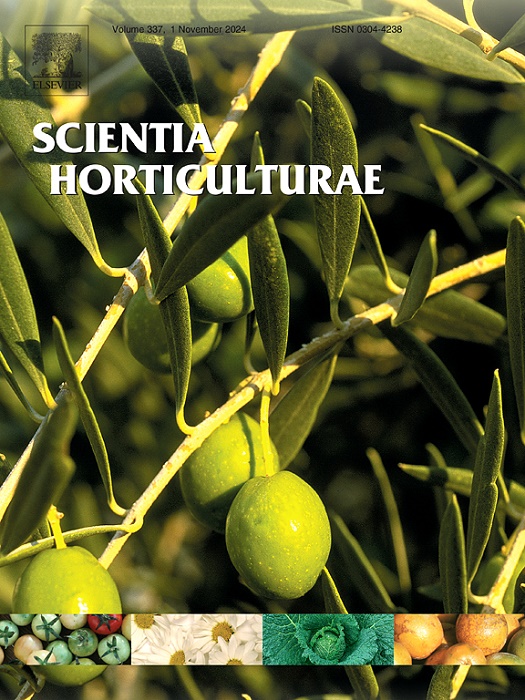Improvement of iron chlorosis and nutrient balance in peach and nectarine trees under the integrated fertilization management using DOP, DRIS, and CND methods
IF 3.9
2区 农林科学
Q1 HORTICULTURE
引用次数: 0
Abstract
Knowledge of the nutritional status of orchards to increase the quantity and quality of the product is a necessary and unavoidable matter. Accordingly, this research was conducted to investigate the effect of fertilizing fruit trees with different integrated treatments of organic, chemical, and biological fertilizers on the correction of iron chlorosis in peach and nectarine trees and the balance of nutrients in the leaves and fruits of treated trees using three indices. Experimental treatments were applied in the form of deep-hole fertilization as follows: completely rotten manure (A), manure + urea + diammonium phosphate + Fe-EDDHA (B), manure + urea + diammonium phosphate + Fe-EDDHA + Bacillus (C), manure + urea + diammonium phosphate + Fe-EDDHA + Thiobacillus + powdered sulfur (D), and manure + urea + diammonium phosphate + Fe-EDDHA + Bacillus + Thiobacillus + powdered sulfur (E). The chlorophyll content in the leaves and N, P, K, Fe, Mn, Cu, and Zn contents in the leaves and fruits were measured during two consecutive years. The results reflected that the application of manure without using chemical and biological fertilizers in the treatment A led to a decrease in the leaf content of N, P, K, and Fe below the normal level. The use of mineral fertilizers along with organic fertilizer in the treatment B led to an increase in the levels of N, P, and Fe in the leaves. Although the addition of Bacillus solution to the treatment C increased the leaf content of these nutrients, they were still below the optimum level. Based on Cate-Nelson analysis of variance, the yields of 50.1 and 43.2 kg tree-1 were obtained as critical limits to separate the high-yielding community (treatments D and E) from the low-yielding community (treatments A, B and C) in peach and nectarine trees, respectively. Nutrient balance indices (DOP, DRIS, and CND) showed that Fe and P were the most limiting nutrients in peach and nectarine leaves and fruits in the low-yielding community. According to the results, the integrated fertilization management in the treatment E had the greatest effect on improving iron chlorosis and showed a balanced and optimal nutritional instruction for peach and nectarine leaves and fruits in the calcareous soils. Reducing pH due to the use of sulfur and Thiobacillus was an effective strategy in increasing the availability of P and Fe in such soils along with the use of organic and mineral fertilizers.
采用 DOP、DRIS 和 CND 法进行综合施肥管理,改善桃树和油桃树的铁萎黄病和养分平衡状况
要提高果园产品的数量和质量,了解果园的营养状况是必要的,也是不可避免的。因此,本研究采用有机肥、化肥和生物肥的不同综合处理方法对果树施肥,利用三个指标研究了施肥对桃树和油桃树铁萎黄病的矫正效果以及处理后果树叶片和果实的养分平衡情况。实验处理以深孔施肥的形式进行,具体如下:完全腐熟的粪肥(A)、粪肥+尿素+磷酸二铵+Fe-EDDHA(B)、粪肥+尿素+磷酸二铵+Fe-EDDHA+芽孢杆菌(C)、粪肥 + 尿素 + 磷酸二铵 + Fe-EDDHA + 硫杆菌 + 硫磺粉(D),以及粪肥 + 尿素 + 磷酸二铵 + Fe-EDDHA + 芽孢杆菌 + 硫杆菌 + 硫磺粉(E)。连续两年测定了叶片中的叶绿素含量以及叶片和果实中的氮、磷、钾、铁、锰、铜和锌含量。结果表明,在处理 A 中,施用粪肥而不使用化学肥料和生物肥料会导致叶片中的氮、磷、钾和铁含量下降,低于正常水平。在处理 B 中,使用矿物肥料和有机肥会导致叶片中氮、磷和铁的含量增加。虽然在处理 C 中添加芽孢杆菌溶液增加了叶片中这些养分的含量,但仍低于最佳水平。根据卡特-尼尔森方差分析,桃树和油桃树的产量分别为 50.1 和 43.2 公斤树-1,这是区分高产群落(处理 D 和 E)和低产群落(处理 A、B 和 C)的临界值。养分平衡指数(DOP、DRIS 和 CND)表明,铁和磷是低产群落中桃和油桃叶片和果实中最主要的限制性养分。结果表明,处理 E 中的综合施肥管理对改善铁萎黄病效果最好,并为石灰性土壤中的桃和油桃叶片和果实提供了均衡和最佳的营养指导。使用硫磺和硫杆菌来降低 pH 值,是在使用有机肥和矿物质肥料的同时增加此类土壤中磷和铁的可用性的有效策略。
本文章由计算机程序翻译,如有差异,请以英文原文为准。
求助全文
约1分钟内获得全文
求助全文
来源期刊

Scientia Horticulturae
农林科学-园艺
CiteScore
8.60
自引率
4.70%
发文量
796
审稿时长
47 days
期刊介绍:
Scientia Horticulturae is an international journal publishing research related to horticultural crops. Articles in the journal deal with open or protected production of vegetables, fruits, edible fungi and ornamentals under temperate, subtropical and tropical conditions. Papers in related areas (biochemistry, micropropagation, soil science, plant breeding, plant physiology, phytopathology, etc.) are considered, if they contain information of direct significance to horticulture. Papers on the technical aspects of horticulture (engineering, crop processing, storage, transport etc.) are accepted for publication only if they relate directly to the living product. In the case of plantation crops, those yielding a product that may be used fresh (e.g. tropical vegetables, citrus, bananas, and other fruits) will be considered, while those papers describing the processing of the product (e.g. rubber, tobacco, and quinine) will not. The scope of the journal includes all horticultural crops but does not include speciality crops such as, medicinal crops or forestry crops, such as bamboo. Basic molecular studies without any direct application in horticulture will not be considered for this journal.
 求助内容:
求助内容: 应助结果提醒方式:
应助结果提醒方式:


